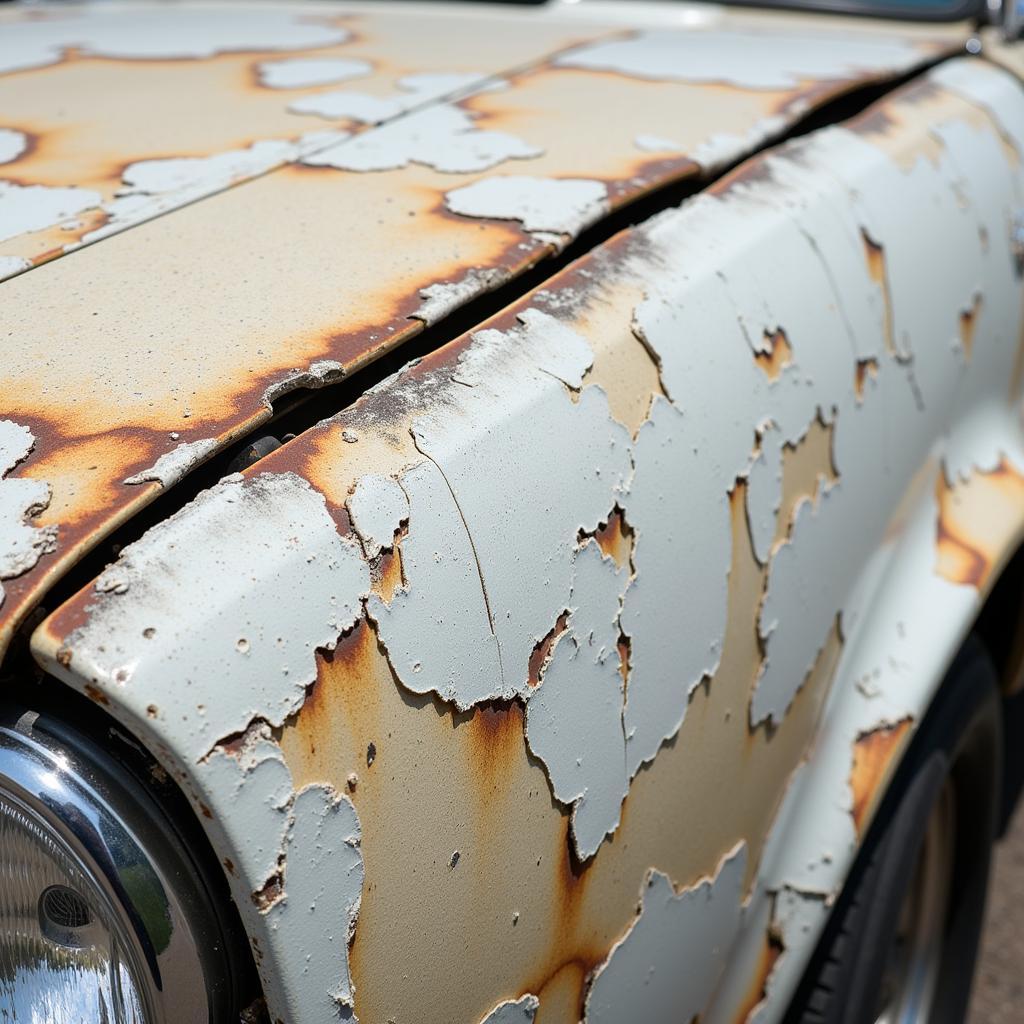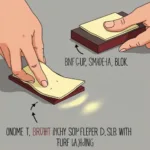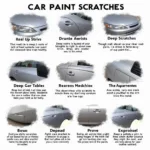Peeled paint repair on your car can be tackled effectively with the wealth of resources available on YouTube. This guide provides comprehensive information and expert tips, helping you navigate the world of DIY car paint repair and achieve professional-looking results. Whether you’re a seasoned DIYer or a complete beginner, this article offers valuable insights, from understanding the causes of peeling paint to choosing the right repair method and executing it flawlessly.
Understanding Why Your Car’s Paint is Peeling
Before diving into the repair process, understanding the root cause of peeling paint is crucial. Common culprits include sun exposure, harsh weather conditions, improper car washing techniques, and even low-quality paint jobs. Identifying the reason behind the peeling helps choose the best repair approach and prevent recurrence. Is it clear coat failure, a reaction to environmental factors, or perhaps damage from a minor scrape? Understanding this will influence your next steps.
YouTube Tutorials: A Treasure Trove of DIY Knowledge
YouTube is a fantastic resource for visual learners, offering a wealth of tutorials on peeled paint repair. From simple touch-ups to more extensive repairs, you’ll find videos covering various techniques, tools, and products. However, it’s important to be discerning. Look for videos from reputable sources with clear instructions and demonstrated expertise. Pay attention to the comments section for additional tips and user experiences.
 Close-up view of peeled paint damage on a car
Close-up view of peeled paint damage on a car
Gathering the Right Tools and Materials
Once you’ve identified the cause and chosen a repair method, gathering the right tools and materials is essential. This might include sandpaper, primer, paint, clear coat, masking tape, and applicators like brushes or spray guns. Quality materials are key to a durable and professional-looking finish. Don’t skimp on these; investing in good products will save you time and frustration in the long run.
Prepping the Damaged Area: The Foundation of a Successful Repair
Prepping the damaged area is crucial for proper paint adhesion. This involves cleaning the area thoroughly, removing any loose paint flakes with a scraper or sandpaper, and sanding the surrounding area to create a smooth transition. This step is often overlooked but is fundamental to achieving a seamless repair. Proper surface preparation ensures the new paint adheres correctly, preventing future peeling.
Applying Primer, Paint, and Clear Coat: The Art of the Repair
Applying the primer, paint, and clear coat requires patience and precision. Follow the instructions on your chosen products carefully, applying thin, even coats and allowing ample drying time between each application. Whether you’re using a brush, roller, or spray gun, consistent application is key to a smooth, professional-looking finish.
Common Mistakes to Avoid in Peeled Paint Repair
Avoid common mistakes like using mismatched paint, skipping the primer, or applying thick coats that can lead to runs and drips. Patience and attention to detail are crucial for a flawless finish. Rushing the process can compromise the quality of the repair, leading to further issues down the line.
When to Call a Professional: Recognizing Your Limits
While DIY repairs are often feasible, there are instances where professional intervention is necessary. Extensive damage, complex paint issues, or lack of the necessary tools and expertise warrant seeking help from a qualified auto body shop. Knowing your limits and seeking professional help when needed ensures a quality repair and prevents further damage.
Conclusion: Restoring Your Car’s Finish with Confidence
Peeled paint repair, even with the aid of helpful YouTube tutorials, requires careful planning, preparation, and execution. By understanding the causes of peeling paint, selecting the right materials, and following proper techniques, you can effectively restore your car’s finish. Remember, patience is key to achieving professional-looking results. With the right approach, your car can look its best once again, showcasing a revitalized and well-maintained exterior.
FAQ
- Can I use any type of paint for my car? No, using automotive paint specifically designed for your car’s make and model is crucial for color matching and durability.
- How long does it take for the paint to dry completely? Drying times vary depending on the product used, but it generally takes 24-48 hours for complete curing.
- Do I need to sand the entire car before repainting a small area? No, you only need to sand the area around the peeled paint to create a smooth transition.
- What is the best way to prevent paint peeling in the future? Regular washing and waxing, parking in shaded areas, and addressing minor chips and scratches promptly can help prevent future peeling.
- Can I use a hairdryer to speed up the drying process? While a hairdryer can help with initial drying, it’s important to let the paint cure naturally for optimal durability.
- How can I find a reputable auto body shop for professional repairs? Check online reviews, ask for recommendations from friends or family, and get multiple quotes before making a decision.
- Is it necessary to use a clear coat after applying the paint? Yes, a clear coat protects the paint from UV rays, environmental damage, and adds a glossy finish.
Common Peeled Paint Repair Scenarios
- Small chips and scratches: Touch-up paint and a clear coat can address these minor imperfections.
- Peeling clear coat: Sanding and reapplying a clear coat can restore the shine and protect the underlying paint.
- Larger areas of peeled paint: This might require sanding, priming, painting, and applying a clear coat, potentially involving professional assistance.
Related Articles on CarRepairOnline:
- Choosing the Right Automotive Paint
- Understanding Car Paint Codes
- DIY Car Detailing Tips
- Protecting Your Car’s Paint in Harsh Weather
Need expert assistance? Contact us via WhatsApp: +1(641)206-8880, or email us at [email protected]. Our 24/7 customer support team is ready to help.


